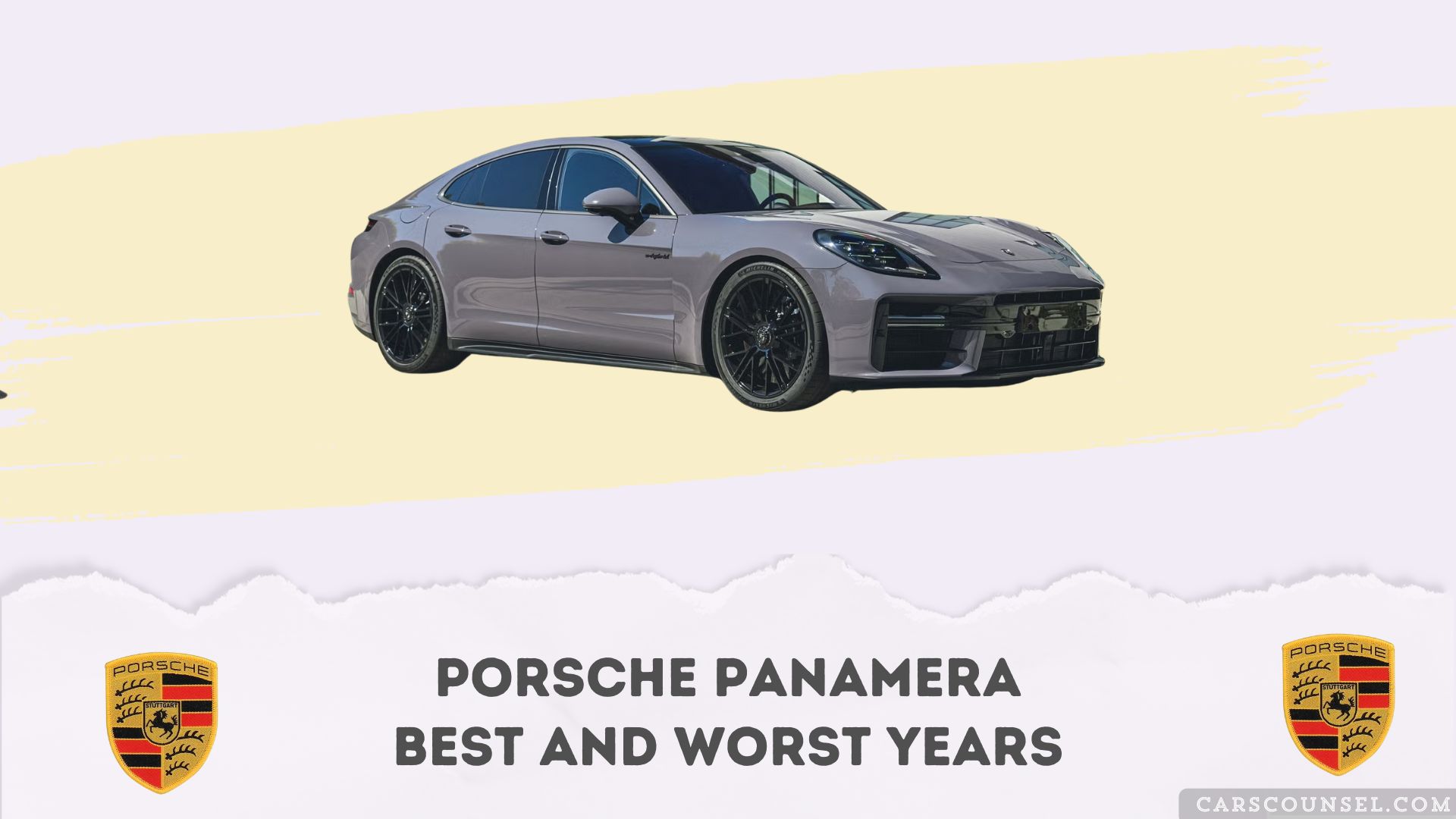As you consider buying a used Porsche Panamera, it’s essential to know which model years to target and which to avoid. You’ll want to focus on the 2013, 2016, and 2018 models, which brought significant improvements in reliability, design, and technology.
But what made these years stand out, and what issues plagued the earlier models? Let’s take a closer look at the Panamera’s evolution to uncover the best and worst years to own one of these luxury sedans.

Quick Navigation
Key Takeaways
- The 2009-2011 models are the worst years to buy due to more problems and higher maintenance costs.
- The 2013 model year marked a significant improvement in reliability, making it a good year to buy.
- Avoid the 2009-2013 models to minimize maintenance costs and issues with adaptive air suspension and active anti-roll bars.
- The 2016 and 2018 models are good options, offering improved performance, design, and technology with lower maintenance costs.
- The 2013 Porsche Panamera is a recommended model, with significant refinements to the first-generation Panamera.
Porsche Panamera Generations and Design
The Porsche Panamera’s evolution spans three generations, each marked by significant design and feature updates.
You’ll notice the first-generation Panamera (2009-2016) introduced a new design language, with a focus on comfort and luxury.
The second-generation Panamera (2016-2024) refined this design, boasting a sleeker, sportier look and improved performance.
The latest third-generation Panamera (2024-present) takes it a step further, featuring updated powertrains, tech, and bodywork changes.
Across all Panamera models, you’ll find a common thread of attention to detail, with a focus on premium materials and a visually appealing interior design centered around the center console.
Performance and Features Across Models
Across the Panamera lineup, you’ll discover a diverse range of performance options, each tailored to suit distinct driving preferences. The original Panamera offered 4.8L S and V8 twin-turbo models, with a 4wd, V6 Base, GTS, and Turbo S added later. A diesel and hybrid option were introduced in 2011, but the diesel version was discontinued due to environmental concerns.
| Model | Engine | Features |
|---|---|---|
| Base | V6 | all-wheel drive, PASM |
| S | V8 twin-turbo | Sport Chrono package, rear spoiler |
| GTS | V8 twin-turbo | all-wheel drive, Active Suspension Management (PASM) |
| Turbo S | V8 twin-turbo | Sport Chrono package, rear spoiler |
| Hybrid | V6 hybrid | all-wheel drive, low emissions |
When buying a Porsche Panamera, consider your performance needs and plunge into the world of options, then choose accordingly.
Reliability and Maintenance Costs Over the Years
When considering a used Porsche Panamera, you’ll want to be aware of the model years that are more prone to issues and higher maintenance costs.
The earliest models, specifically 2009-2011, are known to have more problems, whereas the 2013 model year marked a significant improvement in reliability.
As you research different model years, it’s essential to understand the trends in maintenance costs and how they’ll impact your ownership experience.
Worst Years to Avoid
What’s the best way to avoid a financial pitfall when buying a used Porsche Panamera?
It’s by avoiding the worst years, which are 2009-2013.
The 2009-2011 models have issues with the adaptive air suspension, Porsche Dynamic Chassis Control, and active anti-roll bars.
Early V8 Panameras (2009-2011) have glued coolant pipes that fail over time, causing leaks.
The 2010-2012 models have problems with the speed-activated rear spoiler, while the 2011-2013 models have issues with the 7-speed PDK dual clutch transmission.
Additionally, the 2009-2012 models have faulty door handles and paint quality issues.
Model Year Changes
The Porsche Panamera has undergone significant changes throughout its model years, impacting its reliability and maintenance costs.
The 2013 model year brought refinements to the first-generation Panamera, making it a reliable option.
The 2016 model year introduced the second-generation Panamera, offering improved performance, practicality, and technology.
You’ll find the Panamera range, including the Sport Turismo, requires premium fuel and features advanced stability control.
The 2018 Panamera GTS offers a performance-oriented drive, while the 2020 model year brought updated powertrains and technology.
These model year changes have improved the Panamera’s overall safety rating and driving experience.
Maintenance Cost Trends
As you plunge into the world of Porsche Panamera ownership, understanding the maintenance cost trends is crucial for anticipating and budgeting for future expenses.
Over the years, the Panamera’s reliability and maintenance costs have improved, with later models being more reliable and having lower maintenance costs.
- The 2009-2011 models are the worst years for maintenance costs, with issues like coolant leaks and engine problems.
- The 2013 facelift brought significant improvements, with fewer issues and lower maintenance costs.
- The 2016 second-generation Panamera has an even better reliability record, with low maintenance costs and few issues.
Common Issues to Watch Out For in Early Models
If you’re considering purchasing an early model Porsche Panamera, it’s crucial to be aware of the common issues that may arise, potentially saving you from costly repairs down the line.
Be cautious of glued coolant pipes that can fail over time, causing leaks and expensive repairs. The adaptive air suspension, Porsche Dynamic Chassis Control, and active anti-roll bars can also experience technical issues, leading to costly fixes if not properly maintained.
Additionally, the PCCB brake option can be prone to premature wear, and engine fault codes must be carefully monitored to avoid misdiagnosis.
Best Years to Buy a Used Porsche Panamera
You’re likely considering purchasing a used Porsche Panamera, and knowing which years to focus on can make all the difference.
Good news: there are several great options to choose from.
- The 2013 Porsche Panamera is a good year to buy, as it brought significant improvements to the first-generation model, including a facelift and new engine options.
- The 2016 Porsche Panamera is another good year, as it introduced the second-generation model, which offered improved performance, design, and technology.
- The 2018 Porsche Panamera GTS is a good option for those looking for a high-performance variant, offering a unique blend of power and luxury.
Pros and Cons of Owning a Porsche Panamera
Owning a Porsche Panamera is a commitment that comes with a unique set of benefits and drawbacks.
On the plus side, you’ll enjoy a luxury driving experience, advanced technology, and a good reliability record, with Porsche consistently ranking high in J.D. Power’s dependability study.
However, you’ll need to ponder high maintenance costs, complex technology that can lead to expensive repairs if not properly maintained, and thirsty V8 engines.
Additionally, the exterior design may not appeal to everyone, and the diesel version is no longer available.
Weigh these pros and cons carefully before making a decision to ponder.
When looking at performance cars, make sure to check out our guides on models like the Porsche 996, Porsche 997, Porsche Boxster and Porsche Cayenne. Knowing which model years to target and which to avoid is crucial. Our expert reviews break down these models, providing insights into the years that are celebrated for their engineering excellence and driving satisfaction, as well as those that are best to avoid due to potential issues.

